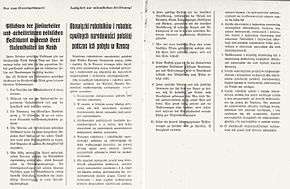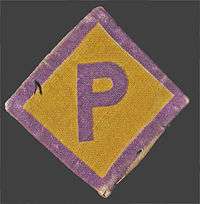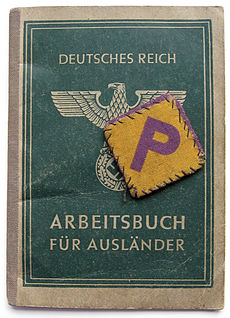Polish decrees
Polish decrees, Polish directives or decrees on Poles (German: Polen-Erlasse, Polenerlasse) were the decrees of the Nazi Germany government announced on 8 March 1940 during World War II[1] to regulate the working and living conditions of the Polish workers (Zivilarbeiter) used during World War II as forced laborers in Germany.[1] The regulation intentionally supported and even created anti-Polish racism and discrimination on the grounds of ethnicity and racial background.[1]:72

Purpose
_Gauverband_Danzig_Westpreu%C3%9Fen_(Association_of_the_%E2%80%9Cshire_or_county%E2%80%9D%2C_Gdansk%2C_West_Prussia).png)

The decrees were an important step towards codifying Nazi Germany policies and laws on foreign forced labor.[1] They were meant to provide a legal basis for discriminating against Poles, fulfilling at the same time Nazi ideology and the needs of the Nazi economy.[1] The racist notion of the inferiority of the forced laborers and prisoners of war from Poland when compared with the German master race was a prominent feature of the orders.[1]:72 The decrees, which recommended that examples of severe punishment be demonstrated to workers early on, were also aiming at clearly distinguishing the new conditions from pre-war voluntary seasonal labor.[1]:74
Specific content
Polish workers were required to wear a clearly visible letter "P" badge, in addition to a work permit with a photo.[1]:72 The letter "P" badge was to be to worn on the right breast of every garment worn. Those who did not obey the rules were subject to a fine of up to 150 RM [Reichsmarks] and arrested with a possible penalty of six weeks detention. They should also be kept away from German "cultural life" and "places of amusement" (this included churches and restaurants).[1]:72 Sexual relations between Poles and Germans was prohibited as Rassenschande (race defilement), and so it was recommended that the same numbers of Polish males and females should be recruited, or that brothels should be set up.[1]:72[1]:73 To keep them segregated from the German population, they were often housed in segregated barracks behind barbed wire.[2] Mobility of workers, housed as far away as possible from Germans, was to be restricted, hence they were barred from using public transportation.[1]:72 They were also affected by after dark curfew.[1]:72 Wages paid to Polish workers, in the minority of cases where they were paid at all, were much lower than those paid to the German workers, even through they had to work longer hours.[1]:73[2] Polish workers were also to receive substandard nutrition. They were not allowed certain types of possessions (bicycles, cameras). They often were denied holidays and had to work seven days a week. They could not enter a marriage without permission. Births were discouraged, and children were sometimes taken away from their families (see kidnapping of Polish children by Nazi Germany).
Punishments for disobedience for Polish workers included being sent to a concentration camp and the death penalty.[1]:74[1]:73 Germans who disobeyed those laws by helping or sympathizing with the workers were to be punished as well, in extreme cases, by being sent to concentration camps.[1]:74
Maintain the purity of German blood! That applies to both men and women! Just as it is considered the greatest disgrace to become involved with a Jew, any German engaging in intimate relations with a Polish male or female is guilty of sinful behavior. Despise the bestial urges of this race! Be racially conscious and protect your children. Otherwise you will forfeit your greatest asset: your honor![3]
Application


After the invasion of Poland, Poles over the age of 14 living in the General Government were subject to compulsory labor.[4] In 1939 there were about 300,000 prisoners from Poland working in Germany;[5] Already in 1944 there were about 2,8 m Polish Zivilarbeiters in Germany (approximately 10% of Generalgouvernement workforce)[6] and a similar number of workers in this category from other countries.[5] Forced laborers worked in agriculture, but also manufacturing.[7]
Where voluntary recruitment failed to yield a required number of workers, penalties were issued on communities that failed to provide workers (confiscation of property, fines); later, manhunts were organized (see łapanka).[8]
Workers' lives were almost totally regimented.[1]:74
In December 1941 the decrees were supplemented by Polish Criminal Regulation (Polenstrafrechtsverordnung), which introduced shortened trials for Poles in criminal cases. In February 1942 Eastern decrees (Ostarbeitererlasse) were issued concerning the OST-Arbeiter (workers from territories taken from Soviet Union); based on the Polish decrees.[9]
See also
Notes
- Ulrich Herbert (1997). Hitler's Foreign Workers: Enforced Foreign Labor in Germany Under the Third Reich. Cambridge University Press. p. 71. ISBN 978-0-521-47000-1.
- "Poles: Victims of the Nazi Era". United States Holocaust Memorial Museum. Archived from the original on 3 March 2013. Retrieved 24 May 2013.
- Ulrich Herbert (1997). Hitler's Foreign Workers: Enforced Foreign Labor in Germany Under the Third Reich. Cambridge University Press. pp. 76–77. ISBN 978-0-521-47000-1.
- Diemut Majer (2003). "Non-Germans" Under the Third Reich: The Nazi Judicial and Administrative System in Germany and Occupied Eastern Europe with Special Regard to Occupied Poland, 1939–1945. JHU Press. ISBN 978-0-8018-6493-3.
- John C. Beyer; Stephen A. Schneider. "Forced Labor under Third Reich - Part 1" (PDF). Nathan Associates Inc. Archived from the original (PDF) on 19 March 2009. Retrieved 17 July 2009. and John C. Beyer; Stephen A. Schneider. "Forced Labor under Third Reich – Part 2" (PDF). Nathan Associates Inc. Archived from the original (PDF) on 19 March 2009. Retrieved 17 July 2009.
- A. Paczkowski, Historia Powszechna/Historia Polski, Wydawnictwo Naukowe PWN, Warszawa 2008, tom 16, p. 28
- Reinhold Billstein (1 January 2004). Working for the Enemy: Ford, General Motors, and Forced Labor in Germany During the Second World War. Berghahn Books. p. 144. ISBN 978-1-84545-013-7.
- M. L. Bush (2 November 2000). Servitude in Modern Times. Wiley. p. 226. ISBN 978-0-7456-1730-5.
- Ulrich Herbert (1997). Hitler's Foreign Workers: Enforced Foreign Labor in Germany Under the Third Reich. Cambridge University Press. p. xvii. ISBN 978-0-521-47000-1.
External links
- (in German) Die "Polenerlasse" vom 8. März 1940 (The "Poland edicts of 8 März 1940 March 1940)
- Poster: "Poles! Recently were executed: Zlosnik Josef (for aggravated assault on his employer), Sikora Stanislaus (for rape), Domagala Wladyslaw (for aggravated burglary), Pesko Josef (for arson). You shall recognize by this: Who is working will live well in Germany! Who does not want to work will be forced to do so! Who is violating the German war and moral laws will be hanged!"